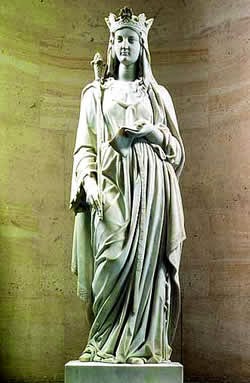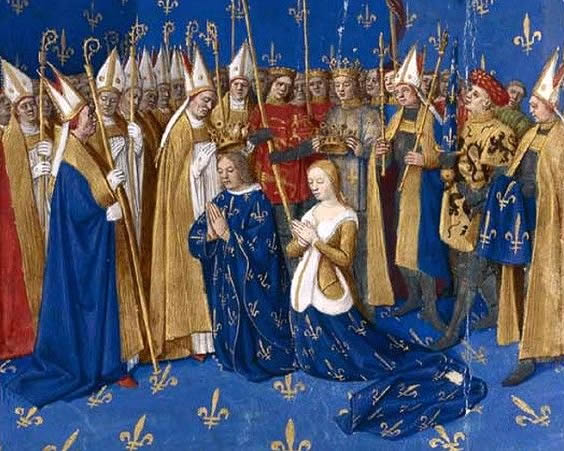World History
Blanche was born in Palencia, present-day Spain, the third daughter of Alfonso VIII, the king of Castile, and Eleanor, daughter of English king Henry II and Queen Eleanor of Aquitaine. She married Louis VIII (1187–1226) of France, the son of Philip II (1165–1223) of France, on May 23, 1200 at Portmouth, in English territory, as part of a treaty between Philip and King John of England (1167–1216).
The aging Queen Eleanor (1122–1204), her maternal grandmother, personally escorted the vivacious Blanche to France. John granted to Blanche as fiefs Gracay and Issoudun, as well as some English Crown lands. Blanche and Louis had 12 children over an 18-year period, but six children died. Their son Louis IX (1214–70) was the heir to the French throne and was later canonized as Saint Louis because of his pious and kind-hearted nature.
While waiting for the French crown, Louis claimed the English crown in Blanche’s name and she offered him her avid support, although Philip dissented. Blanche worked tirelessly and organized the invasion from Calais. Louis’s invasion of England was initially well received by the barons, but he later received only scant support from the other inhabitants.
It was also unsuccessful because King John died, and after 18 months the novelty wore off and most people offered allegiance to young King Henry III (1206–72). The Treaty of Lambeth ended Louis’s English adventure. Louis was crowned on July 14, 1223.
He became ill with dysentery upon his return to Paris from the Albigensian Crusade that he had quelled and died at Montpensier on November 8, 1226. Blanche was left to act as regent for 12-year-old Louis, and she served as legal guardian of the other children.
Seeing an opportunity, the barons and the counts of Champagne, Brittany, and LaMarche (to name a few) revolted against Blanche’s somewhat suppressive hand, secretly aided by Henry. With astounding capability Blanche broke up the league of barons.
She also repeatedly repelled assaults by Henry III, who fought to have lands obtained by Philip returned to England. Blanche forced Robert de Sorbon (1201–74), founder of the University of Paris, to accept her authority. Blanche also extended French territory by adding the area of the Midi to the Crown lands, and made beneficial alliances.
Upon Louis’s service on the Seventh Crusade, Blanche served as regent from 1248 until 1250, when she served as co-regent with her son Alphonse until 1252. Blanche helped raise the exorbitant ransom for Louis’s release from prison in the Holy Land. Her influence on Louis remained strong until her death.
Blanche’s health failed on November 1252 at Melun. She was moved to Paris but died soon thereafter and was buried at Maubuisson. Blanche is remembered as one of the most capable rulers of the Middle Ages. Saint Louis, known in history as the best of France’s medieval monarchs, was aided during his reign by Blanche’s advice and determination.
- Hugh Capet
Hugh Capet The founder of the Capetian dynasty of French kings (987–1328), Hugh Capet was born the second son of Hugh the Great, duke of Francia and count of Paris, and Hedwig, sister of Otto I, the emperor of Germany. In 961 he was made duke of...
- Philip Ii Augustus
Philip II Augustus, king of France (r. 1180–1223), was, born in 1165, to Louis VII (1137–80) and his third wife, Adèle of Champagne, near Paris. Following the custom of the Capetian dynasty, Louis had young Philip crowned at Reims cathedral...
- Louis Xi
Louis XILouis XI, son of Charles VII, was a king of France from the Valois dynasty that had replaced the Capetian dynasty a century earlier. A schemer whose reputation in history was solidified when Sir Walter Scott condemned him a century later, Louis...
- Mary Tudor (mary Of France)
Mary Tudor was born in 1496, nine years after her father, Henry VII, had become king of England by defeating Richard III at Bosworth in 1485. Mary Tudor is often confused with Mary I, who was queen of England from 1553 to 1558, and with Mary, Queen of...
- Valois Dynasty
Valois Dynasty The branch of the Capet family who ruled France from 1328 to 1589, the Valois, descended from 1285 when Philip III gave the county of Valois to his brother Charles. Charles’s son succeeded to the throne of France when the direct...
World History
Blanche of Castile
 |
| Blanche of Castile |
The aging Queen Eleanor (1122–1204), her maternal grandmother, personally escorted the vivacious Blanche to France. John granted to Blanche as fiefs Gracay and Issoudun, as well as some English Crown lands. Blanche and Louis had 12 children over an 18-year period, but six children died. Their son Louis IX (1214–70) was the heir to the French throne and was later canonized as Saint Louis because of his pious and kind-hearted nature.
While waiting for the French crown, Louis claimed the English crown in Blanche’s name and she offered him her avid support, although Philip dissented. Blanche worked tirelessly and organized the invasion from Calais. Louis’s invasion of England was initially well received by the barons, but he later received only scant support from the other inhabitants.
It was also unsuccessful because King John died, and after 18 months the novelty wore off and most people offered allegiance to young King Henry III (1206–72). The Treaty of Lambeth ended Louis’s English adventure. Louis was crowned on July 14, 1223.
He became ill with dysentery upon his return to Paris from the Albigensian Crusade that he had quelled and died at Montpensier on November 8, 1226. Blanche was left to act as regent for 12-year-old Louis, and she served as legal guardian of the other children.
Seeing an opportunity, the barons and the counts of Champagne, Brittany, and LaMarche (to name a few) revolted against Blanche’s somewhat suppressive hand, secretly aided by Henry. With astounding capability Blanche broke up the league of barons.
She also repeatedly repelled assaults by Henry III, who fought to have lands obtained by Philip returned to England. Blanche forced Robert de Sorbon (1201–74), founder of the University of Paris, to accept her authority. Blanche also extended French territory by adding the area of the Midi to the Crown lands, and made beneficial alliances.
 |
| Coronation of Louis VIII and Blanche of Castille |
Upon Louis’s service on the Seventh Crusade, Blanche served as regent from 1248 until 1250, when she served as co-regent with her son Alphonse until 1252. Blanche helped raise the exorbitant ransom for Louis’s release from prison in the Holy Land. Her influence on Louis remained strong until her death.
Blanche’s health failed on November 1252 at Melun. She was moved to Paris but died soon thereafter and was buried at Maubuisson. Blanche is remembered as one of the most capable rulers of the Middle Ages. Saint Louis, known in history as the best of France’s medieval monarchs, was aided during his reign by Blanche’s advice and determination.
- Hugh Capet
Hugh Capet The founder of the Capetian dynasty of French kings (987–1328), Hugh Capet was born the second son of Hugh the Great, duke of Francia and count of Paris, and Hedwig, sister of Otto I, the emperor of Germany. In 961 he was made duke of...
- Philip Ii Augustus
Philip II Augustus, king of France (r. 1180–1223), was, born in 1165, to Louis VII (1137–80) and his third wife, Adèle of Champagne, near Paris. Following the custom of the Capetian dynasty, Louis had young Philip crowned at Reims cathedral...
- Louis Xi
Louis XILouis XI, son of Charles VII, was a king of France from the Valois dynasty that had replaced the Capetian dynasty a century earlier. A schemer whose reputation in history was solidified when Sir Walter Scott condemned him a century later, Louis...
- Mary Tudor (mary Of France)
Mary Tudor was born in 1496, nine years after her father, Henry VII, had become king of England by defeating Richard III at Bosworth in 1485. Mary Tudor is often confused with Mary I, who was queen of England from 1553 to 1558, and with Mary, Queen of...
- Valois Dynasty
Valois Dynasty The branch of the Capet family who ruled France from 1328 to 1589, the Valois, descended from 1285 when Philip III gave the county of Valois to his brother Charles. Charles’s son succeeded to the throne of France when the direct...
